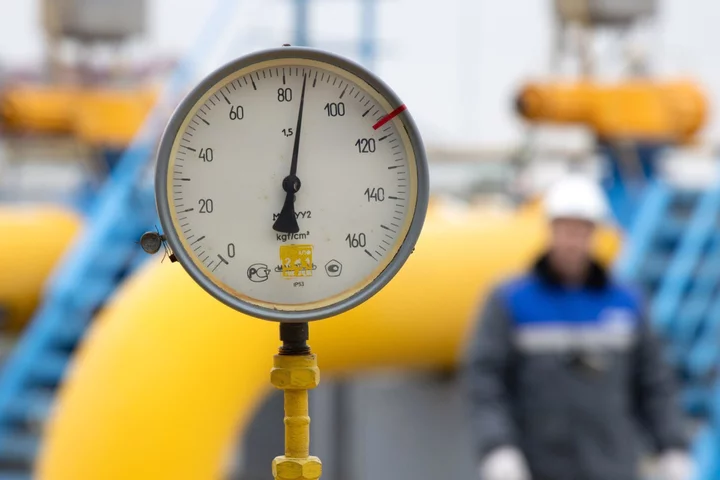Since the Kakhovka dam burst on June 6, the floods have cut off any chance Ukraine’s troops might have had of crossing the Dnipro River in support of their counteroffensive. Yet that benefit to the Kremlin may not last.
Below the dam, floodwaters already have begun to recede and eventually will return the river to its former state, if with new obstacles such as washed up land mines and debris. Upstream, as the 230-kilometer (140-mile) long Kakhovka reservoir basin empties, an entirely new landscape is emerging that could potentially create opportunities for Ukrainian forces.
Already, the Washington-based Institute for the Study of War is redrawing its battlefield maps to reflect the sudden shrinkage of the water course that separates Ukrainian forces from the occupied land on the eastern banks of the reservoir.
The dam was destroyed just as Ukrainian forces began a counteroffensive, months in the planning, that seeks to recapture territory lost to Russia in the south and east of the country following last year’s invasion.
As Kyiv deploys billions of dollars of western weaponry along a front stretching for 1,000 miles, the Dnipro is a crucial feature of the battlefield, offering protection to troops facing each other across much of its southern portion and posing a major logistical challenge to Ukrainian strategists working out how to keep their forces supplied as they advance.
The eventual extent of that barrier will depend on how severely the dam has been damaged, as well as on the silt that has collected on the reservoir’s floor since the dam’s construction in 1956.
“The key question here is the height of the dam that remained underwater after the destruction,” said Illya Perevozchykov, who heads the hydrology department of Ukraine’s national meteorological service said in a phone interview. “This height defines the amount of water that is going to stay.”
The Dnipro has been central to Ukraine’s identity and economy for centuries. Soviet engineers turned the river into a cascade of six huge reservoirs, each with a hydroelectric dam to produce power for the industrial heartland on its banks. Kakhovka was the last before the river empties into the Black Sea, forming a huge natural barrier between the opposing armies.
But by Sunday, the reservoir’s water level had dropped by about half, releasing 73% of its volume, Ukrhydroenergo director Ihor Syrota said in a Youtube interview with Radio Liberty. Newly exposed silt banks make it impossible for agency staff to move now stranded monitoring stations close enough to measure the reduced levels directly, he said.
On Wednesday, Syrota said reservoir levels are expected to continue falling, and floodwaters to recede for another week.
The surface under the water is made up of silt and it’s hard to say how fast that will then dry, according to Perevozchykov. Predicting what, if anything, that will in turn mean for the opposing militaries is even harder, given that the terrain and its condition will be completely new.
Russia has occupied the damaged area of the dam for months, but denies responsibility for causing its collapse. Ukraine and its allies reject that.
Could Putin Really Be Prosecuted for War Crimes?: QuickTake
Kremlin Warns Mideast That Fresh Curbs on Finance Will Hit Trade
But for the moment, the two sides seem to agree on the military impact.
With the flood for now eliminating any threat from across the Dnipro, Russian commanders have redeployed troops from positions along the river to shore up defenses further east, Ukraine’s Deputy Defense Minister Hanna Malyar said on June 11.
President Vladimir Putin called the breach “better for us,” in unusually frank televised comments on the war Tuesday. He said the dam’s destruction had thwarted an alleged Ukrainian plan to attack across the river, while also lamenting Russia’s low stocks of modern weapons and the loss of 54 tanks to Ukraine’s week-old counteroffensive. He said Ukraine lost 160 tanks in the fight so far, a figure vastly higher than has been independently verified.
Should the reservoir empty completely, a Dnipro reduced to its pre-dam state between Nova Kakhovka and Zaporizhzhia would be a much smaller obstacle to forces seeking to cross it, with an average depth of about 3 meters, instead of 16.5. The span any Ukrainian force would need to cross north of the dam also would shrink sharply, from a maximum of 23 kilometers, to about one.
In its un-dammed state, the Dnipro also often divided into smaller channels as it meandered, according to maps made in 1954, shortly before the Kakhovka dam’s construction.
The original riverbed under the reservoir had broad marshes, but also bridges over narrower points, including at Nikopol, a town just across the Dnipro from Europe’s largest nuclear power plant. The facility remains under Russian control.
The Dnipro cuts through Ukraine’s north-south spine and begins at the boggy southern end of Russia’s Valdai hills, where Putin has one of his presidential retreats.
Dams on the river were blown up twice during World War II as part of defensive operations, although both of those tactics ultimately failed.
In 1941 Soviet dictator Josef Stalin blew the river’s first dam, which he’d built just nine years earlier near Zaporizhzhia, to slow approaching German armies. The flood killed an estimated 20,000 to 100,000 people, including drowned Soviet troops that weren’t warned in time.
The Germans rebuilt the dam under occupation, before blowing it up again in 1943 as they used the Dnipro to stiffen a defensive line against a massive Soviet counteroffensive.
While the military role that the Kakhovka dam’s destruction will play this time remains unclear, it’s economic impact is easier to predict. The reservoir fed multiple factories, the nuclear power plant at Enerhodar and Europe’s largest agricultural irrigation system, as well as the canal supplying water to Crimea, the peninsula Putin annexed from Ukraine in 2014.
According to Ukraine’s Ministry of Agriculture, loss of the irrigation network alone would deprive 584,000 hectares of arable land of water, an area that in 2021 produced 4 million tons of grain and oilseeds worth $1.5 billion.
Despite the hits to agriculture and steel production, Dragon Capital, Ukraine's largest investment manager, doesn't think the immediate economic impact of the floods will be big enough to change its growth forecasts, according to Olena Bilan, the company's chief economist.
That's because economy is currently doing better than expected, said Bilan, even though in the longer term the dam's destruction will mean ``additional costs for reconstruction and recovering from damage.''
“There has been no flood like this in Ukraine, for certain,” said Perevozchykov, the hydrologist. “And probably not in all of Europe.”
--With assistance from Aliaksandr Kudrytski and Demetrios Pogkas.









